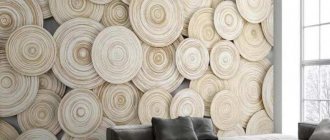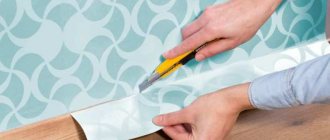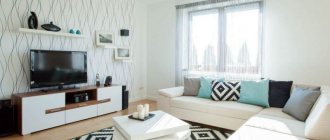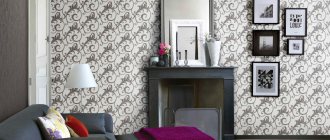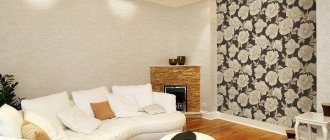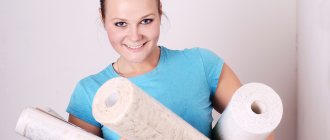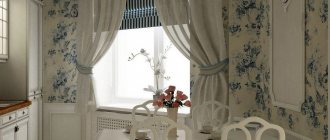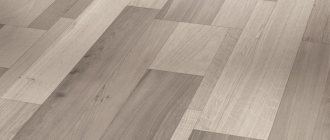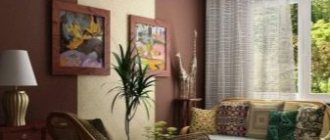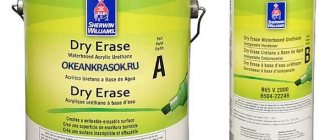One should talk about finishing walls without leveling without fanaticism; such a decision is made based on the actual state of the surfaces. Sometimes plaster may need to be removed, despite its relative smoothness, because it does not adhere well or is too loose. But there are situations when on a rough wall (for example, a panel wall) the surface is quite flat and even almost smooth. When there are only minor defects, there is no point in undertaking expensive and time-consuming plastering. In this case, the best way out of the situation would be wallpaper for uneven walls, which we will help you choose.
Three-dimensional drawing eliminates minor wall defects
What types can be glued to uneven walls?
If you don’t know how to hang wallpaper on uneven walls, then you need to learn about the types of materials. The main options include:
- Paper. Due to the structure and thickness, the glued materials do not stretch over the area. This reduces the receipt of manifested flaws. They can be used when various defects are often found in the apartment.
- Vinyl. This option is applicable when small irregularities are encountered. If you need to do finishing, then vinyl materials will not help, but will only aggravate the situation.
- Liquid. They will allow you to carry out detailed finishing work and eliminate defects in the floor materials.
- Non-woven. This is a dense material that will mask small and medium-sized imperfections.
Non-woven fabric is best. It has a dense structure and can mask flaws of different sizes and shapes.
Solution 2: Texture wallpaper
WALLPAPER BRAVO STEIN 80583BR23
Regular smooth wallpaper does not cope well with surface imperfections, but textured ones can hide them more effectively. Such wallpapers include varieties of vinyl and non-woven coverings and photo wallpapers. The most important thing is the convex pattern.
Foamed Vinyl
performs the task perfectly.
The dense base and voluminous relief of such wallpaper will mask flaws and decorate the room. Hot stamping
is also suitable for such cases. These coatings are durable and have a textured surface, which means imperfections will be completely invisible.
Non-woven wallpaper for painting
- an indispensable assistant in repairs. You can choose different relief patterns and paint them in a suitable color. In this case, the unevenness will visually disappear, and the walls will appear smooth.
Wallpapers and photo wallpapers that imitate natural textures
, will cope well with problematic surfaces. Coverings imitating stone, brick or plaster create a special stylistic mood in the room and turn the disadvantages of the walls into advantages. It is important that such wallpaper be matte. The play of light and shadow on glossy wallpaper will make unevenness visible.
Simple tips for choosing
Thanks to the availability of modern technology, there are a huge number of options available at points of sale. You can even do the work using photo wallpaper. What kind of wallpaper should you put on uneven walls? Among the main options are:
- Choose a material without a clear pattern. It is better to provide an option with diverging stripes and patterns, as well as with different textures of the material.
- It is better to choose bright accents that will be mounted on defects.
- The palette must be selected either in one shade or with bright transitions.
- You cannot resort to geometric shapes.
- It is better to choose a multiple pattern.
- Liquid wallpaper for walls can be chosen either for all surfaces or for individual areas.
Consider the thickness. With greater density, defects will be hidden better.
Products with bright patterns
A bright, rich and intense pattern is best; it will help hide all imperfections. Since when using plain trellises, all irregularities will be emphasized. Therefore they should be avoided. Abstract drawings that are randomly located on the surface have proven themselves especially well. They distract and attract the eye. As practice shows, it is better to use small patterns on the surface, for example, images of flowers or monograms. But, it is better to buy wallpaper that does not require selection of a pattern, so that the joints do not highlight the unevenness on the wall even more.
As for geometric patterns, they are not suitable for hiding irregularities. After all, the curvature of the walls will only stand out more as a geometrically even figure, straight lines will be distorted and will immediately catch the eye.
Difficulty adhering to uneven surfaces
When you need to hide uneven walls with wallpaper , pitfalls may pop up here. You can use the leveling that is done before pasting. But if you do not resort to this procedure, then 3 main difficulties arise:
- You need to glue wallpaper on crooked corners, where the amount of curvature will be enormous.
- The relief is visible even after finishing.
- There are spaces under the canvas that will later form bulges.
What drawings hide irregularities
There are several types of designs and patterns that hide curvature:
- abstract;
- unordered (without obvious sequence and “logic”);
- flowers and monograms (small);
- graffiti;
- with blurred contours;
- with imitation of another coating (decorative plaster, stone, wood, brick).
The disadvantages of the surface are well hidden by wallpaper, the design on which is created using hot stamping technology. This technique combined with any type of pattern listed is a good choice.
What not to glue to crooked plaster
The plaster layer is often crooked. This drawback can be corrected by using wallpaper for curved walls and corners, which can be glued on top of the plaster. And then the corner defects will become less noticeable if everything is glued correctly. It also happens that the surfaces of the walls will look worse after the procedure. This happens due to incorrect selection. The worst practices include:
- Paper base, which consists of 1 layer. Even the smallest defect will be visible here.
- Heavy material. Such decorative covering may fall due to its weight.
- Large drawing. All irregularities are visible under bright lighting.
Solution 3. Thick wallpaper
WALLPAPER MIRABELLA ANACAPRI 1 37301
Wallpapers differ in the density of the material from which they are made, which means they have different masking abilities. Single-layer paper wallpaper is the thinnest option, so it is not the best way to eliminate wall defects. For such cases, duplex, consisting of two layers of thick paper, is more suitable. These coatings are inexpensive and easy to use.
The properties of vinyl and non-woven wallpaper are much better. Coatings with a vinyl layer, especially foam and hot stamping, have increased density
- 200-250 g/m2, and for some manufacturers it can reach up to 400 g/m2. They are easy to clean, resistant to damage, but most importantly, they hide uneven walls.
Non-woven wallpaper is heavy and has a significant thickness. This means that they will not only last for many years, but will also save time on preparing walls and sealing small cracks.
How to stick dense materials on uneven walls
When you had to face the problem of how to correctly glue wallpaper on crooked walls, you need to follow the sequence:
- Using a level, markings are made starting from the corner.
- The working surface is treated with glue and dried.
- A piece of canvas is coated with the composition and applied, creating an overlap on another surface.
- Using a knife, a cut is made along the corner.
- The joints are coated with adhesive.
- The whole room is covered.
The work must be done using the following tools:
- spatulas;
- level, tape measure, knife;
- pencil;
- rags;
- hammer.
Putty knife
Level
Pencil
Rags
Hammer
All processes must be performed using the set listed above and adding to it a roller and containers.
What glue is best for gluing?
Now there are 2 large categories of glue by type:
- Universal. Even when you decide to glue non-woven adhesive wallpaper, you can do it.
- Special. Used only for one type, for example, for vinyl wallpaper.
Special attention should be paid to the dense base. Often a number of problems arise here, because the wallpaper can collapse under its own weight.
Where to begin
If you want to properly glue wallpaper, then first you need to prepare the surface. This should be done using the following steps:
- Old materials are wetted to make gluing easier. Paint and whitewash are also removed. Sometimes you can glue finishing material onto a painted surface. This also applies to the edges of the glued corner if there are uneven corners.
- If there is no finishing, then pasting is done on plaster. You should first check for the absence of delaminations, and if any are present, then the pieces are removed.
- Cracks are sealed with mortar.
- The base is cleaned of dust and dirt.
- The surface is treated with a metal brush.
- It is preferable to use a primer in all situations. This allows you to reduce the absorbency of the adhesive composition.
Only after completing these procedures will you be able to proceed with further operations.
Features of gluing in corners
In old houses you can find uneven corners. And here there are only 2 ways that help eliminate this disease:
- Preparation by leveling. Here the finishing takes place with plaster , putty, and then wallpaper.
- Pasting on the base that already exists. In this situation, you should take into account the features of the products , because some of them will help eliminate defects, while others will do the opposite.
Particular attention should be paid to the second case. Using a number of simple rules, defects can be eliminated quickly:
- The right choice by type, pattern, texture. Thick wallpaper will look best.
- The corner is glued 2 times. The glue is applied to the place where wallpaper 100 mm wide is subsequently glued. Later they are cut through, and the second strip fills the space.
Preparing walls for wallpapering
Before gluing, you need to prepare the work surface. Procedure:
- Explore problem areas. A tape measure and a building level will help here. Serious flaws are worth trying to correct.
- Plaster over deep dents and smooth out small bumps with a sanding block.
- Clean the walls. It is necessary to carefully remove dust, dirt and debris - all this impairs the “setting” of the glue and creates air bubbles.
- Apply primer. The primer mixture improves adhesion and fills small cracks and dents. Do not prime if the wallpaper is glued to old paint.
- Wait for the primer to dry.
Now it makes sense to mark the wall by drawing the borders of the wallpaper strips with a pencil. The procedure is not mandatory, but it is easier to glue, especially when the walls are crooked.
Main problems
Uneven walls can be well camouflaged under wallpaper, but not just any wallpaper. Often the result looks sloppy, and all the bumps become even more visible.
Also, the canvas does not adhere well to a non-smooth surface, and subsequently bubbles remain or the corners even begin to fall off. This is typical for high-density wallpaper, which does not stretch well.
How to remove old wallpaper?
Due to the curvature of the walls, you will have to measure each piece of wallpaper separately, since the angle can vary significantly.

